2D Numerical Analysis of Prefabricated Vertical Drains Using Different Matching Methods
Abstract
:1. Introduction
2. Objectives and Scope
3. Materials and Methodology
3.1. Large Scale Consolidometer Experiment
3.1.1. Soil Properties and Testing Procedures
3.1.2. Soil Model Parameters and Drain Properties
3.2. Full Test Embankment in Eastern China
3.2.1. Soil Profile and Properties for Test Embankment
3.2.2. Model Parameters of Soft Clay and Characteristics of PVDs
3.3. Methodology: Matching Methods
3.3.1. Method A
3.3.2. Method B
3.3.3. Method C
4. Results and Discussion
4.1. FEA of Large-Scale Consolidometer Experiment
4.2. FEA of Full Test Embankment in Eastern China
5. Conclusions
Author Contributions
Funding
Institutional Review Board Statement
Informed Consent Statement
Data Availability Statement
Conflicts of Interest
References
- Holtz, R.D. Prefabricated Vertical Drains: Design and Performance; CIRIA Ground Engineering Report: Ground Improvement; Butterworth-Heinemann Ltd.: Oxford, UK, 1991; 131p. [Google Scholar]
- Indraratna, B.; Redana, I.W. Numerical modeling of vertical drains with smear and well resistance installed in soft clay. Can. Geotech. J. 2000, 37, 132–145. [Google Scholar] [CrossRef]
- Holtz, R.D. Preloading with prefabricated vertical strip drains. Geotext. Geomembr. 1987, 6, 109–131. [Google Scholar] [CrossRef]
- Indraratna, B.; Ratnayake, P. Performance of embankment stabilized with vertical drains on soft clay. J. Geotech. Eng. 1994, 120, 257–273. [Google Scholar] [CrossRef]
- Johnson, S.J. Foundation precompression with vertical sand drains. Soil Mech. Found. Div. 1970, 96, 145–175. [Google Scholar] [CrossRef]
- Aboshi, H. Applied Ground Improvement Techniques, Workshop; Southeast Asian Geotechnical Society (SEAGS); Asian Institute of Technology: Bangkok, Thailand, 1992; 40p. [Google Scholar]
- Kjellman, W. Accelerating consolidation of fine grain soils by means of cardboard wicks. Proc. 2nd ICSMFE 1948, 2, 302–305. [Google Scholar]
- Hansbo, S. Consolidation of fine-grained soils by prefabricated drains. In Proceedings of the 10th International Conference on Soil Mechanics and Foundation Engineering, Stockholm, Sweden, 15–19 June 1981; Volume 3, pp. 677–682. [Google Scholar]
- Ali, F.H. A method to test the performance of a prefabricated vertical drain. Soils Found. 1993, 33, 181–187. [Google Scholar] [CrossRef] [PubMed]
- Geo-Technical Engineering Directorate Research. Prefabricated Vertical Drainage System for Construction of Embankment on Compressible Soft Soil. REPORT NO. GE-R-68. 2004. Available online: https://rdso.indianrailways.gov.in/works/uploads/File/68.pdf (accessed on 2 May 2024).
- Deng, Y.B.; Xie, K.H.; Lu, M.M. Consolidation by vertical drains when the discharge capacity varies with depth and time. Comput. Geotech. 2013, 48, 1–8. [Google Scholar] [CrossRef]
- Bergado, D.T.M.; Balasubramaniam, R. Proposed Criteria for Discharge Capacity of Prefabricated Vertical Drains. Geotext. Geomembr. 1996, 14, 481–505. [Google Scholar] [CrossRef]
- Jamiolkowski, M.L.R.; Wolski, W. Summary of Discussion to Specialty Session 6. In Proceedings of the 8th European Conference on Soil Mechanics and Foundation Engineering, Helsinki, Finland, 23–26 May 1983; Volume 3. [Google Scholar]
- Holtz, R.D.; Jamiolkowski, M.; Lancellota, R.; Pedroni, S. Behavior of bent prefabricated vertical drains. In Proceedings of the 12th International Conference on Soil Mechanics and Foundation Engineering, Rio de Janeiro, Brazil, 3–18 August 1989; Volume 3, pp. 1657–1660. [Google Scholar]
- Chai, J.C.; Miura, N. Investigation of factors affecting vertical drain behavior. J. Geotech. Geoenviron. Eng. 1999, 125, 216–226. [Google Scholar] [CrossRef]
- Ahn, B.J. Improvement Characteristics by Plastic Board Drain Method on Soft Ground in Pusan New Port. Ph.D. Thesis, Hanyang University, Seoul, Republic of Korea, 2010. [Google Scholar]
- Tran-Nguyen, H.H.E.; Schneider, J.A. Effect of deformation of prefabricated vertical drains on discharge capacity. Geosynth. Int. 2010, 17, 431–442. [Google Scholar] [CrossRef]
- Chai, J.C.; Jack, S.L.S.; Martin, D.L.; Da-Jun, Y. Predicting the Performance of Embankments on PVD-Improved Subsoils. Comput. Geotech. 2018, 93, 222–231. [Google Scholar] [CrossRef]
- Chai, J.C.; Miura, N.; Sakajo, S.; Bergado, D. Behavior of vertical drain improved subsoil under embankment loading. Soil Found. 1995, 35, 49–61. [Google Scholar] [CrossRef]
- Rujikiatkamjorn, C.; Indraratna, B. Environmental Sustainability of Soft Soil Improvement via Vacuum and Surcharge Preloading. In Proceedings of the Geo-Congress 2014, Atlanta, GA, USA, 23–26 February 2014; pp. 3658–3665. [Google Scholar]
- Leroueil, S.; Magnan, J.; Tavenas, F. Remblais Sur Argiles Molles; Technique et Documentation Lavoisier: Paris, France, 1985. [Google Scholar]
- Jardine, R.D.; Hight, D.W. The Behaviour and Analysis of Embankments on Soft Clay; The Public Works Research Center of Greece: Athens, Greece, 1987. [Google Scholar]
- Mamat, R.C.; Ramli, A.; Khahro, S.H.; Yusoff, N.I. Numerical Simulation and Field Measurement Validation of Road Embankment on Soft Ground Improved by Prefabricated Vertical Drains: A Comparative Study. Appl. Sci. 2022, 12, 8097. [Google Scholar] [CrossRef]
- Jemal, J.M.; Priyantha, W.J.; Alemayehu, T.; Aydin, Ö. Settlement of a railway embankment on PVD-improved Karakore soft alluvial soil. Eng. Sci. Technol. 2020, 23, 1015–1027. [Google Scholar]
- Quang, D.P. The Viet Tran, Minh Thu Trinh, Evaluation of Asaoka and Hyperbolic Methods for Settlement Prediction of Vacuum Preloading Combined with Prefabricated Vertical Drains in Soft Ground Treatment. J. Eng. Technol. Sci. 2022, 54, 220501. [Google Scholar]
- Mamat, R.C.; Kasa, A.; Razali, S.M. Comparative Analysis of Settlement and Pore Water Pressure of Road Embankment on Yan soft soil Treated with PVDs. Civ. Eng. J. 2019, 5, 1609–1618. [Google Scholar] [CrossRef]
- Hird, C.C.; Pyrah, I.C.; Russell, D.; Cinicioglu, F. Modelling the effect of vertical drains in two-dimensional finite element analyses of embankments on soft ground. Can. Geotech. J. 1995, 32, 795–807. [Google Scholar] [CrossRef]
- Baghbani, A.-N.; Tanveer, C.; Susanga, C.; Johannes, R. Application of artificial intelligence in geotechnical engineering. Earth-Science 2022, 228, 103991. [Google Scholar]
- Yildiz, A.; Karstunen, M. Three-dimensional analyses of PVD-improved soft soils. In Geotechnics of Soft Soils: Focus on Ground Improvement; CRC Press: Boca Raton, FL, USA, 2009; pp. 197–203. [Google Scholar]
- Sloan, A.M. Finite element modelling of prefabricated vertical drains using 1D drainage elements with attached smear zones. Comput. Geotech. 2019, 107, 235–254. [Google Scholar]
- Perera, D.; Indraratna, B.; Leroueil, S.; Rujikiatkamjorn, C.; Kelly, R. Analytical model for vacuum consolidation incorporating soil disturbance caused by mandrel-driven drains. Can. Geotech. J. 2017, 54, 547–560. [Google Scholar] [CrossRef]
- Rujikiatkamjorn, C.; I.ndraratna, B.; Chu, J. 2D and 3D Numerical Modeling of Combined Surcharge and Vacuum Preloading with Vertical Drains. Int. J. Geomech. 2008, 8, 144–156. [Google Scholar] [CrossRef]
- Barron, R.A. Consolidation of fine-grained soils by drain wells. Trans. Am. Soc. Civ. Eng. 1948, 113, 718–724. [Google Scholar] [CrossRef]
- Nguyen, N.T. Applying the Equivalent Plane Strain solution to design the soft soil improvement by vertical drains. J. Min. Earth Sci. 2020, 61, 28–37. [Google Scholar] [CrossRef]
- Chai, J.-C.; Miura, N.; Bergado, D.T. Simple method of modeling PVD improved subsoil. J. Geotech. Geoenviron. Eng. 2001, 127, 965–972. [Google Scholar] [CrossRef]
- Shinsha, H.H.; Abe, Y.; Tanaka, A. Consolidation settlement and lateral displacement of soft ground improved by sand drains. Tsuchi-Kiso. Jpn. Soc. Soil Mech. Found. Eng. 1982, 30, 7–12. [Google Scholar]
- Hird, C.C. Finite element modelling of vertical drains beneath embankments on soft ground. Geotechnic 1992, 42, 499–511. [Google Scholar] [CrossRef]
- Bergado, D.T. Numerical analysis of embankment on subsiding ground improved by vertical drains and granular piles. In Proceedings of the 13th ICSMFE, New Delphi, India, 5–10 January 1994; pp. 1361–1366. [Google Scholar]
- Kim, Y.T.; Lee, S.R. An equivalent model and back-analysis technique for modelling in situ consolidation behavior of drainage-installed soft deposits. Comput. Geotech. 1997, 20, 125–142. [Google Scholar] [CrossRef]
- Indraratna, B.; Redana, I.W. Plane strain modeling of smear effects associated with vertical drains. J. Geotech. Eng. 1997, 123, 474–478. [Google Scholar] [CrossRef]
- Lin, D.G.; Kim, H.K.; Balasubramaniam, A.S. Numerical modelling of prefabricated vertical drain. Geotech. Eng. 2000, 31, 109–125. [Google Scholar]
- Tran, T.A. Equivalent plane strain modelling of vertical drains in soft ground under embankment combined with vacuum preloading. Comput. Geotech. 2008, 35, 655–672. [Google Scholar] [CrossRef]
- Nguyen, B.-P. Consolidation Analysis of PVD-Installed Soft Deposits Considering Soil Disturbance and Discharge Capacity Reduction. Ph.D. Thesis, Pukyong National University South Korea, Busan, Republic of Korea, 2019; p. 147. [Google Scholar]
- Rujikiatkamjorn, C. Analytical and Numerical Modelling of Soft Clay Foundation Improvement via Prefabricated Vertical Drains and Vacuum Preloading. Ph.D. Thesis, University of Wollongong, Wollongong, Australia, 2005. [Google Scholar]
- Saowapakpiboon, J.B.D.; Voottipruex, P.; Lam, L.G.; Nakakuma, K. PVD improvement combined with surcharge and vacuum preloading including simulations. Geotext Geomembr. 2011, 29, 74–82. [Google Scholar] [CrossRef]
- Bergado, D.T.; Shui-Long, S. Modelling prefabricated vertical drain improved ground in plane strain analysis. Proc. Inst. Civ. Eng.-Ground Improv. 2013, 166, 65–77. [Google Scholar]
- Brinkgreve, R.B. PLAXIS, Finite Element Code for Soil and Rock Analyses; 2D-Version 8; Balkema: Rotterdam, The Netherlands, 2002. [Google Scholar]
- Janbu, N. Soil models in offshore engineering (25th rankine lecture). Géotechnique 1985, 35, 241–280. [Google Scholar] [CrossRef]
- Sathananthan, I. Modeling of Vertical Drains with Smear Installed in Soft Clay; University of Wollongong: Wollongong, NSW, Australia, 2005. [Google Scholar]
- Wang, Z.M.; Xu, L.X.; Jiang, Z.H. Field experimental study on the soft ground treatment of Hongzhou-Niingbo (HN) expressway foundation. In Soft Ground Treatment in Hangzhou-Ningbo Expressway; Cai, T.L., Ed.; Hongzhou Press: Hongzhou, China, 1998; pp. 183–222. [Google Scholar]
- Taylor, D.W. Fundamentals of Soil Mechanics; John Wiley and Sons Inc.: New York, NY, USA, 1948. [Google Scholar]
- Tavenas, F.; Larouch, G.; Leroueil, S. In Situ Measurement of Permeability in Soft Clays, in ASCE Specialty Conference on Use of In-Situ Tests in Geotechnical Engineering, Blacksburg. 1986, pp. 1034–1048. Available online: https://api.semanticscholar.org/CorpusID:138956835 (accessed on 2 May 2024).
- Sekiguchi, H.; Shibata, T.; Fujimoto, A.; Yamaguchi, H. A Macro-Element Approach to Analyzing the Plane Strain behavior of Soft Foundation with Vertical Drains. Proceedings of the 31st Symposium of the JGS. 1986, pp. 111–116. Available online: https://cir.nii.ac.jp/crid/1573668924697940096 (accessed on 2 May 2024). (In Japanese).
- Hansbo, S. Consolidation of clay by band shaped prefabricated drains. Ground Eng. 1979, 12, 16–25. [Google Scholar]
- Hird, C.C. Predictions for the Stanstead Abbotts Trial Embankment. Prediction Symposium on a Reinforced Embankment; King’s College: London, UK, 1986. [Google Scholar]
- Russell, D. Finite Element Analysis of Embankments on Soft Ground Incorporating Reinforcement and Drains. Ph.D. Thesis, University of Sheffield, Sheffield, UK, 1992. [Google Scholar]
- Leroueil, S.; Magnan, J.-P.; Tavenas, F. Embankment on Soft Clays; Ellis Horwood Limited: Chichester, UK, 1990. [Google Scholar]
- Shen, S.-L.; Chai, J.H.; Hong, Z.-S. Analysis of field performance of embankments on soft clay deposit with and without PVD-improvement. J. Geotext. Geomembr. 2005, 23, 463–485. [Google Scholar] [CrossRef]
- Russell, D.; Hird, C.C. Discussion of Performance of embankment stabilized with vertical drains on soft clay, by B. Indraratna, A.S. Balasubramaniam, and P. Ratnayake. J. Geotech. Eng. 1995, 121, 389–391. [Google Scholar] [CrossRef]
- Sundström, S. Numerical Analyses of a PVD-Improved Embankment on Soft Soil. Chalmers University of Technology: Chalmers, Sweden, 2023. [Google Scholar]
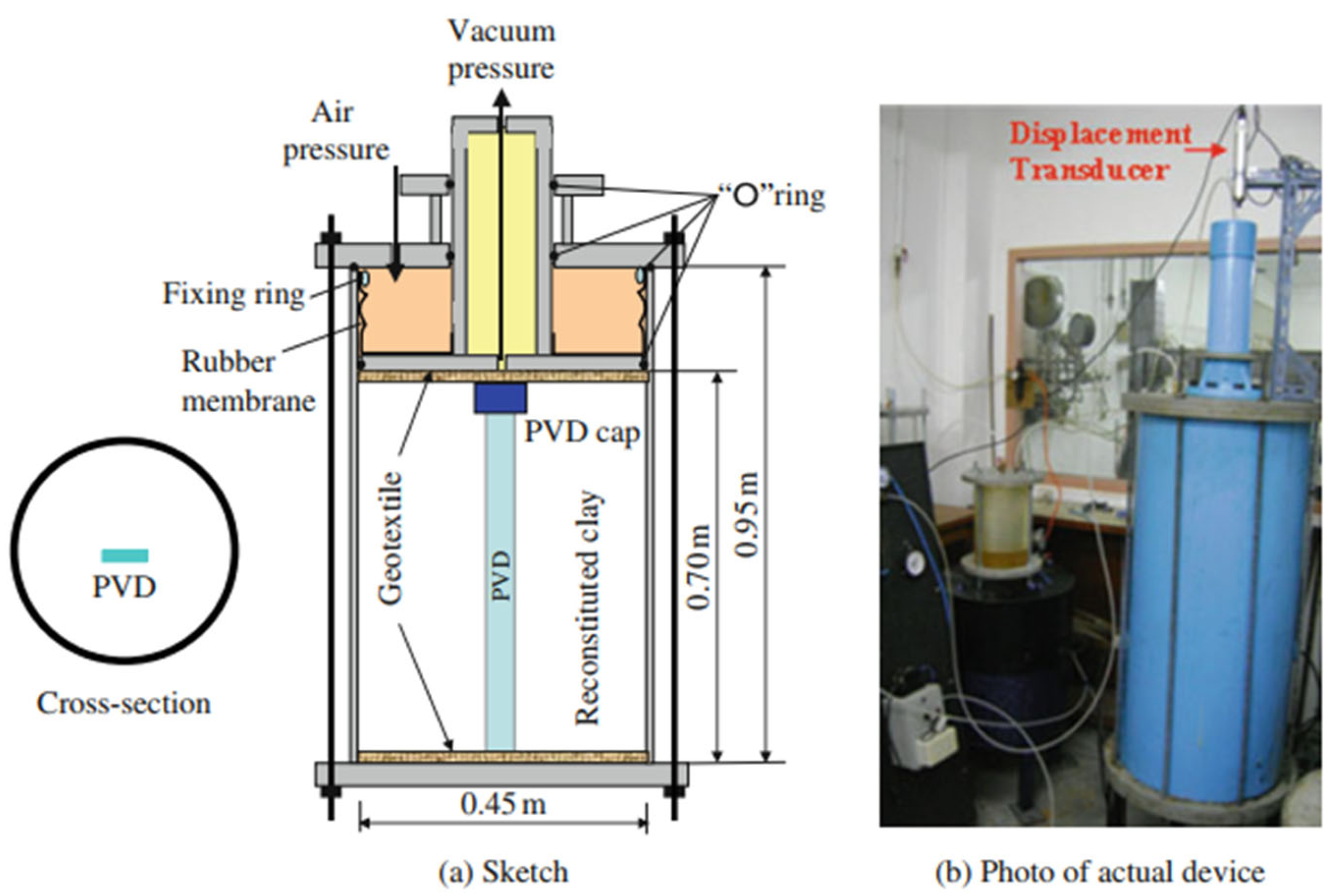
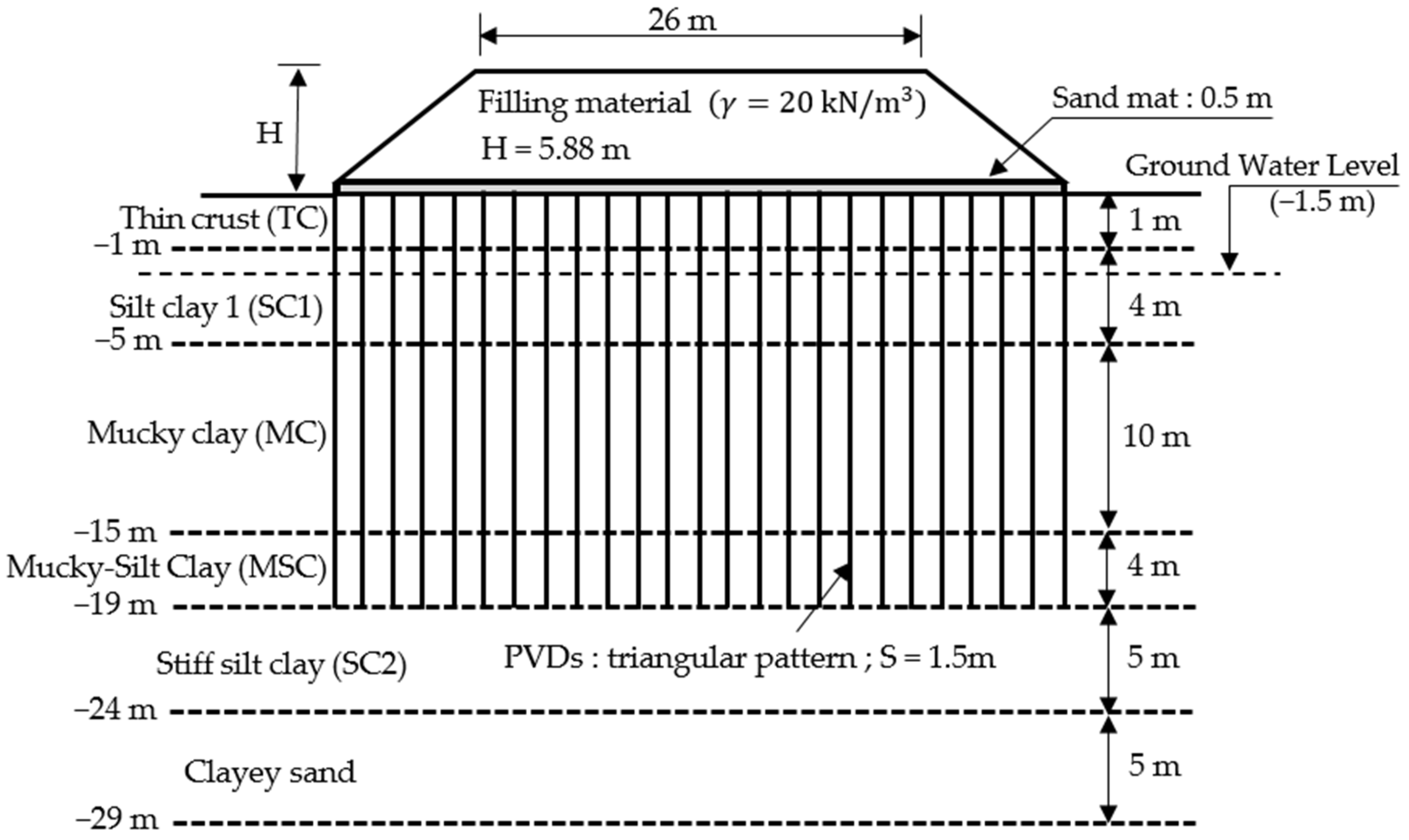
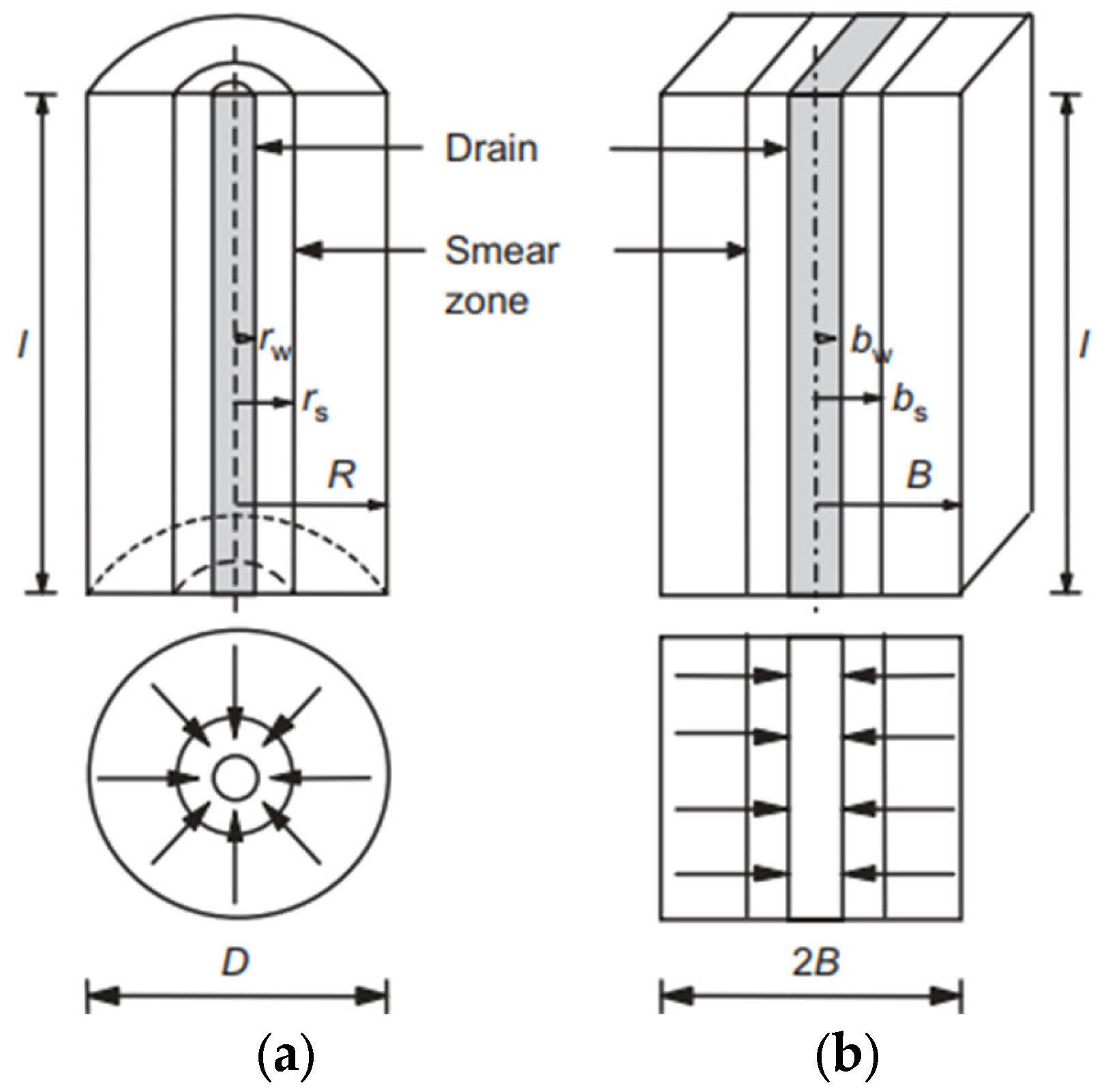
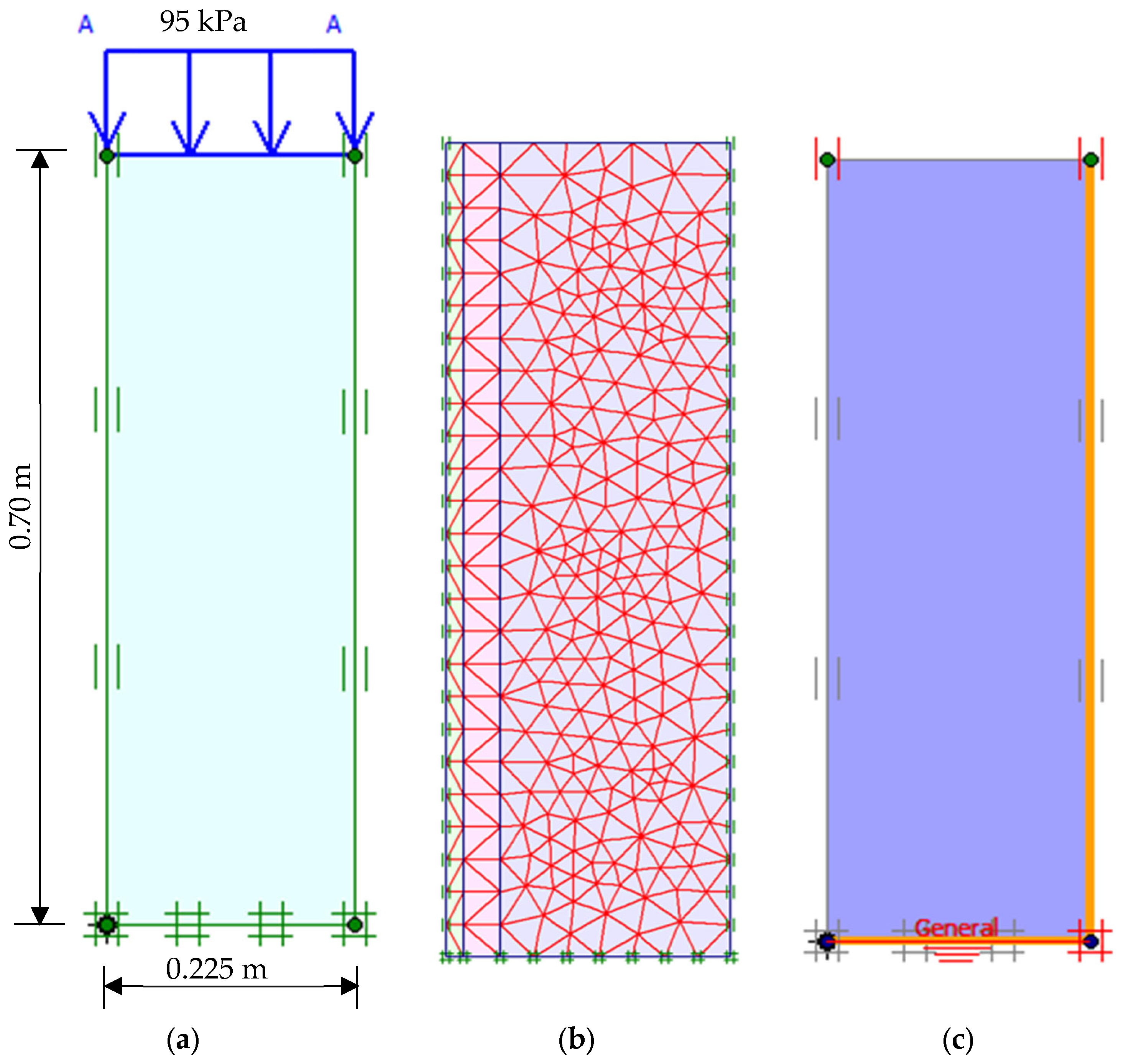
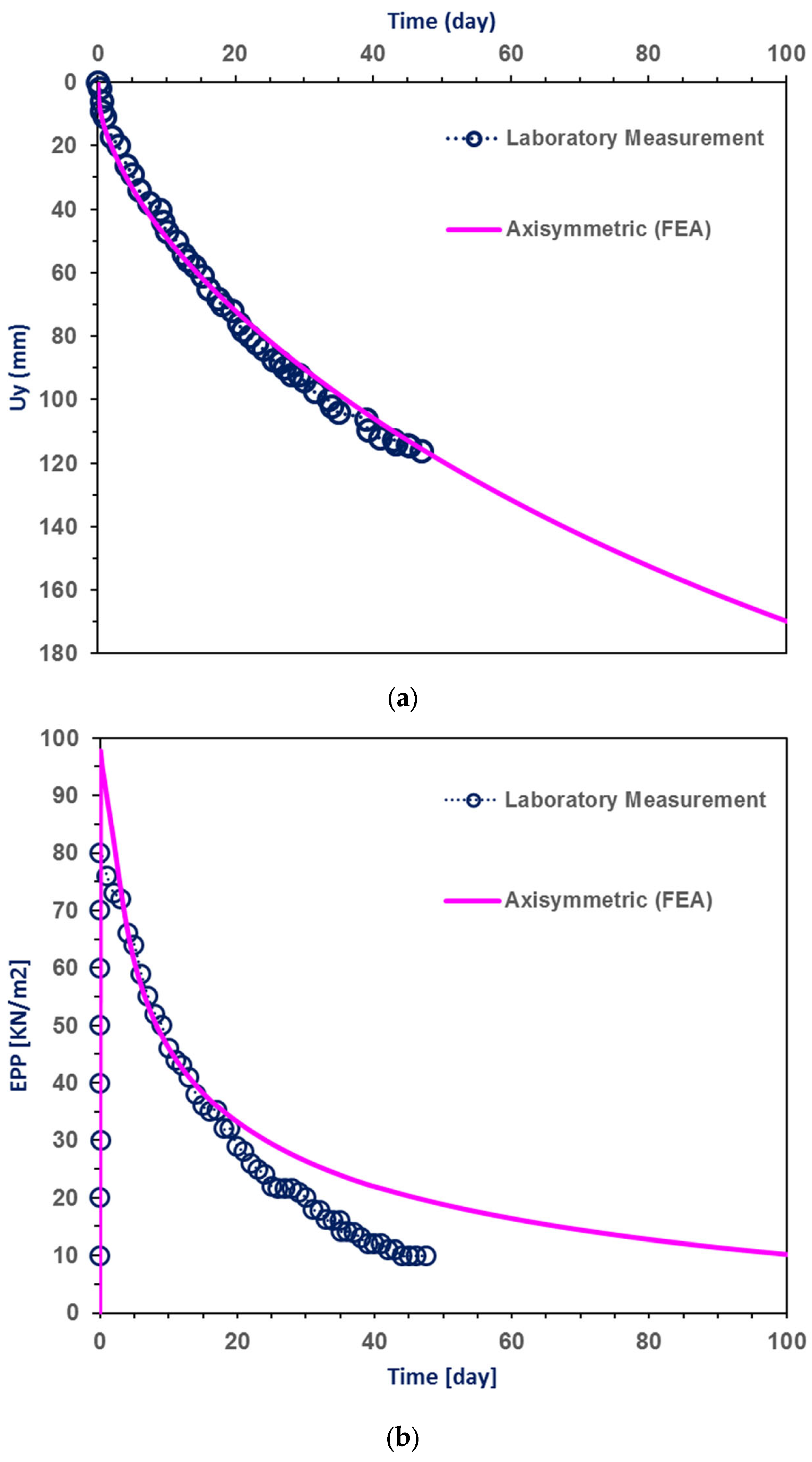

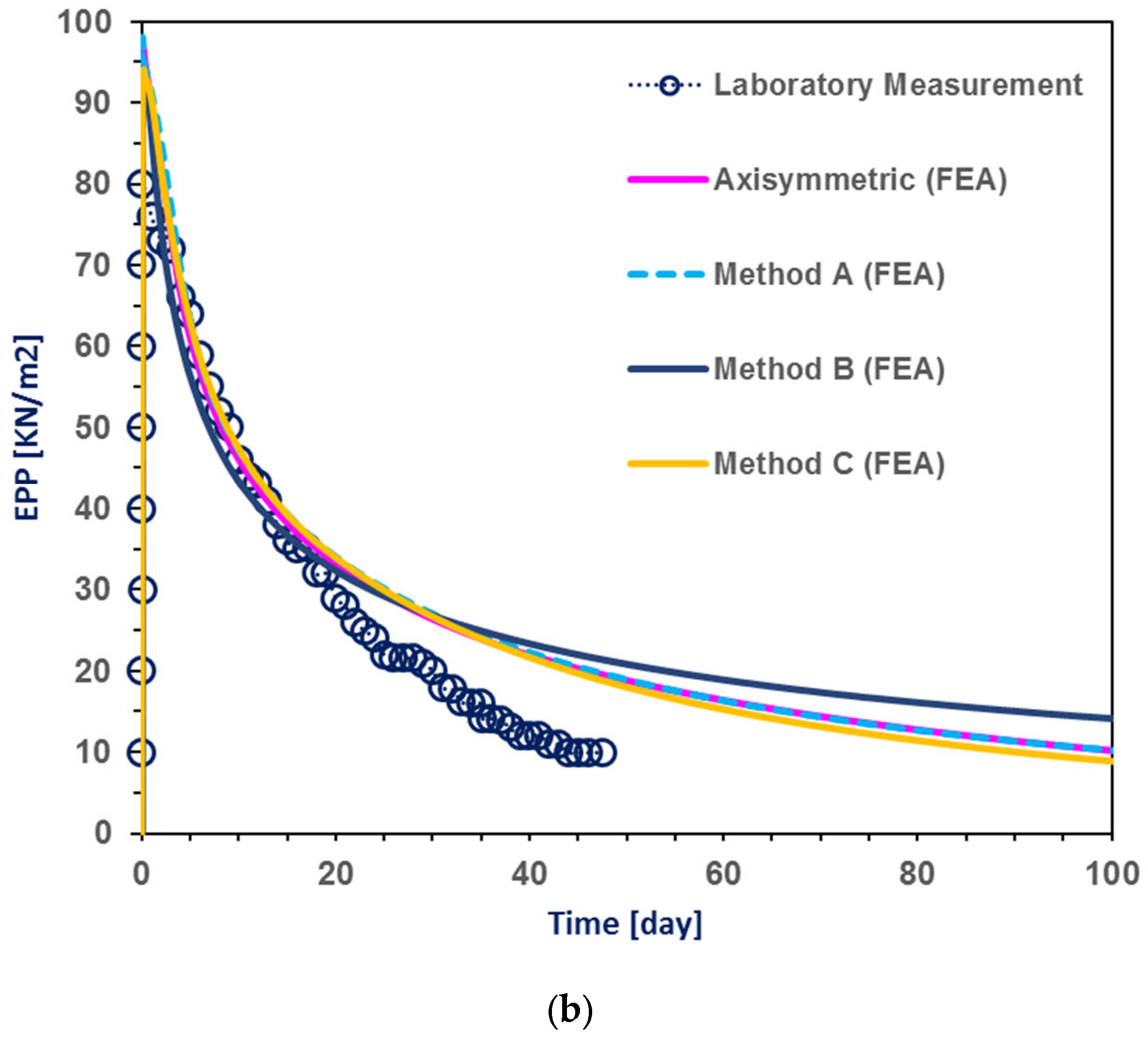
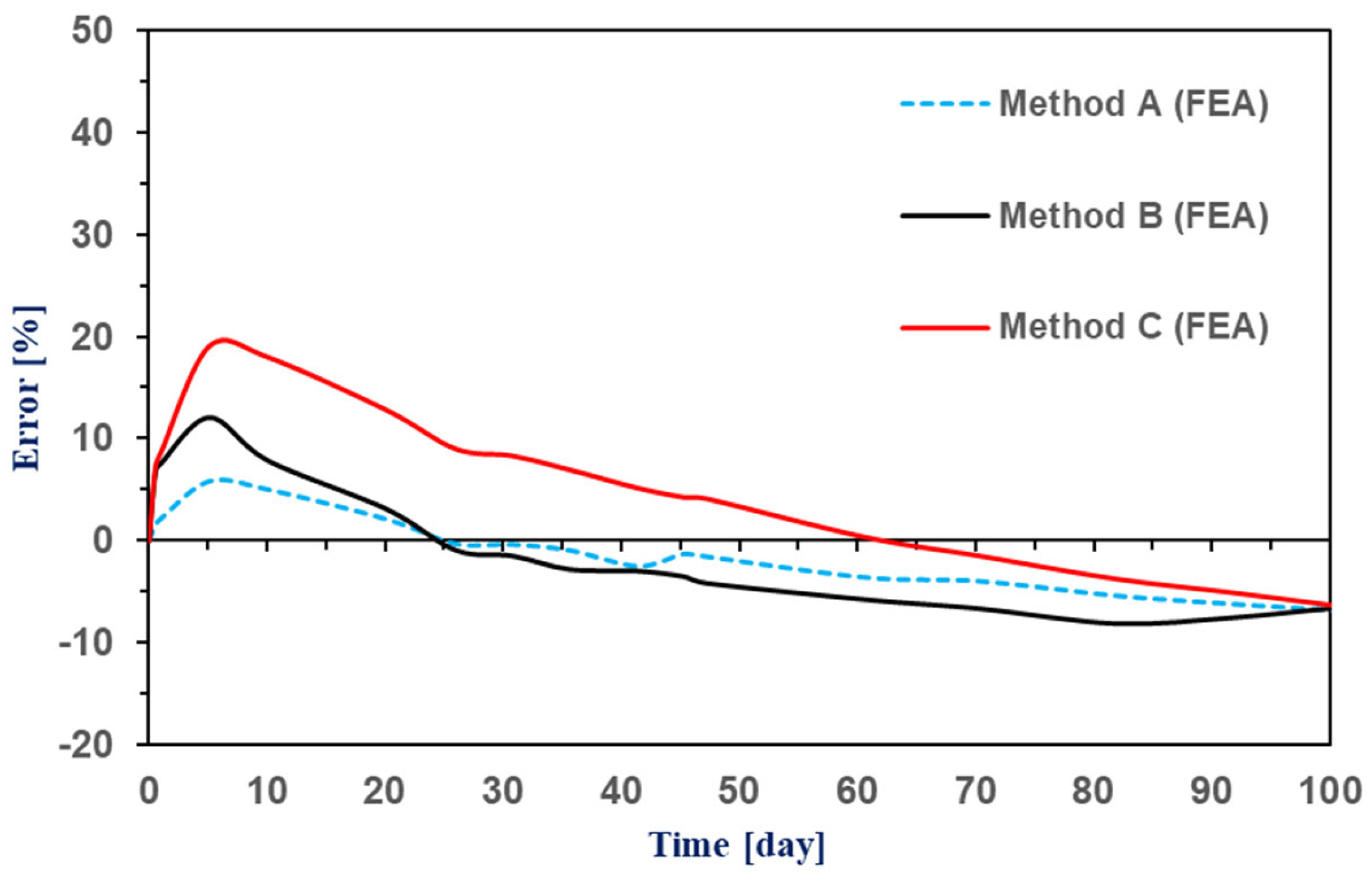
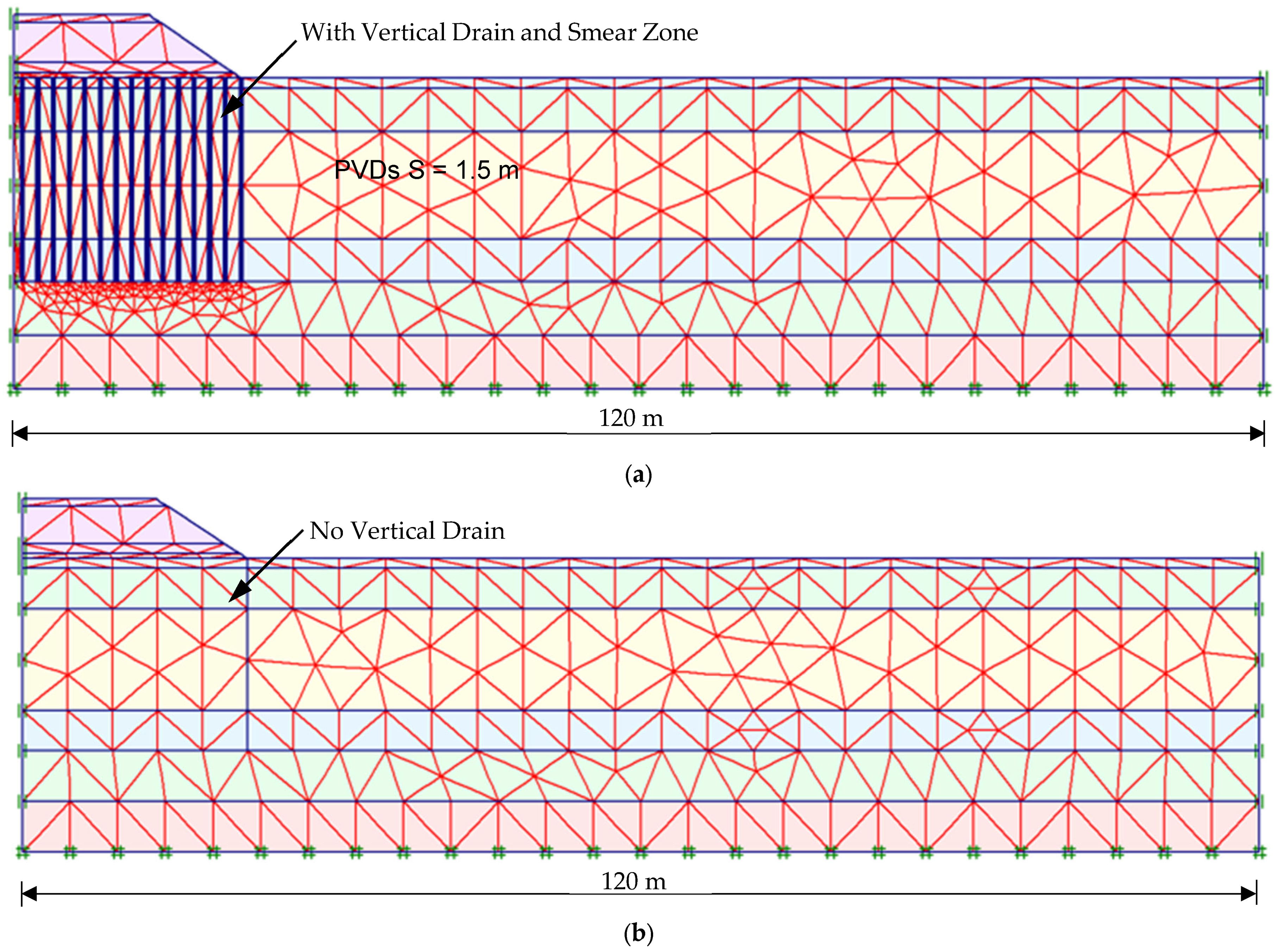
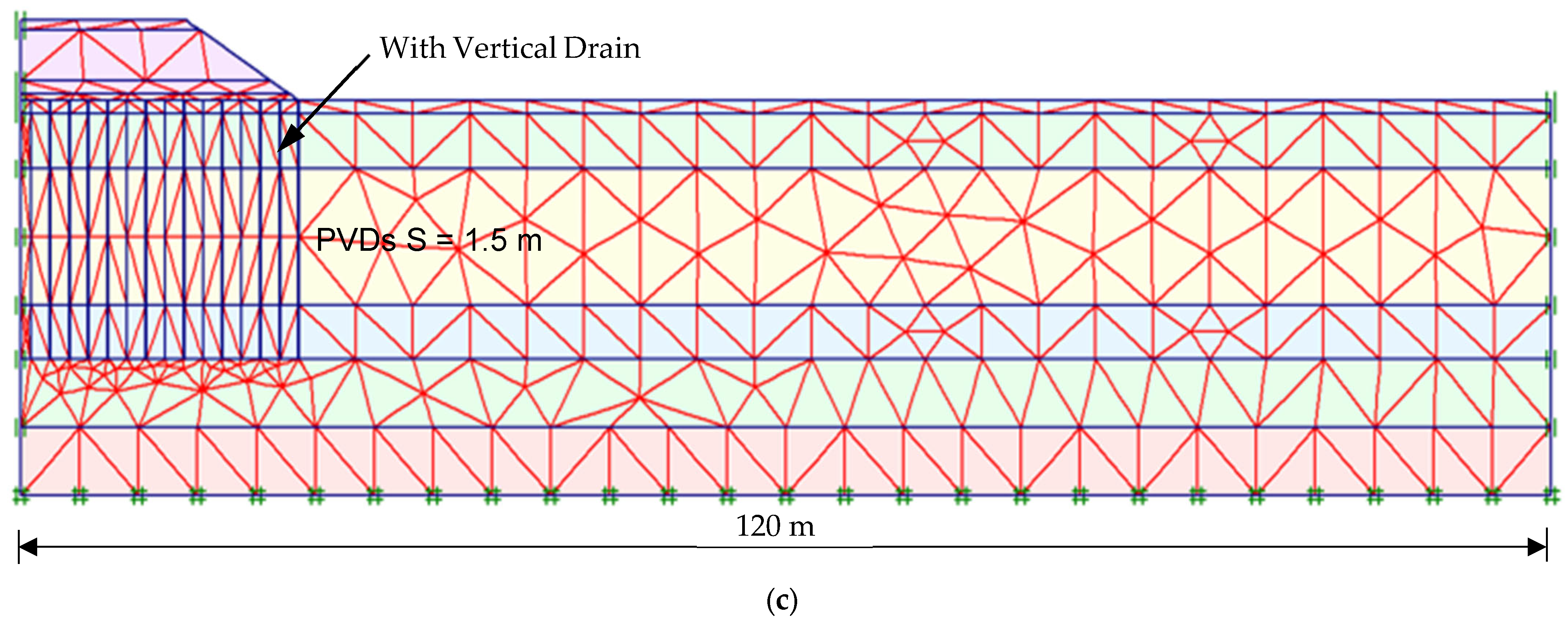
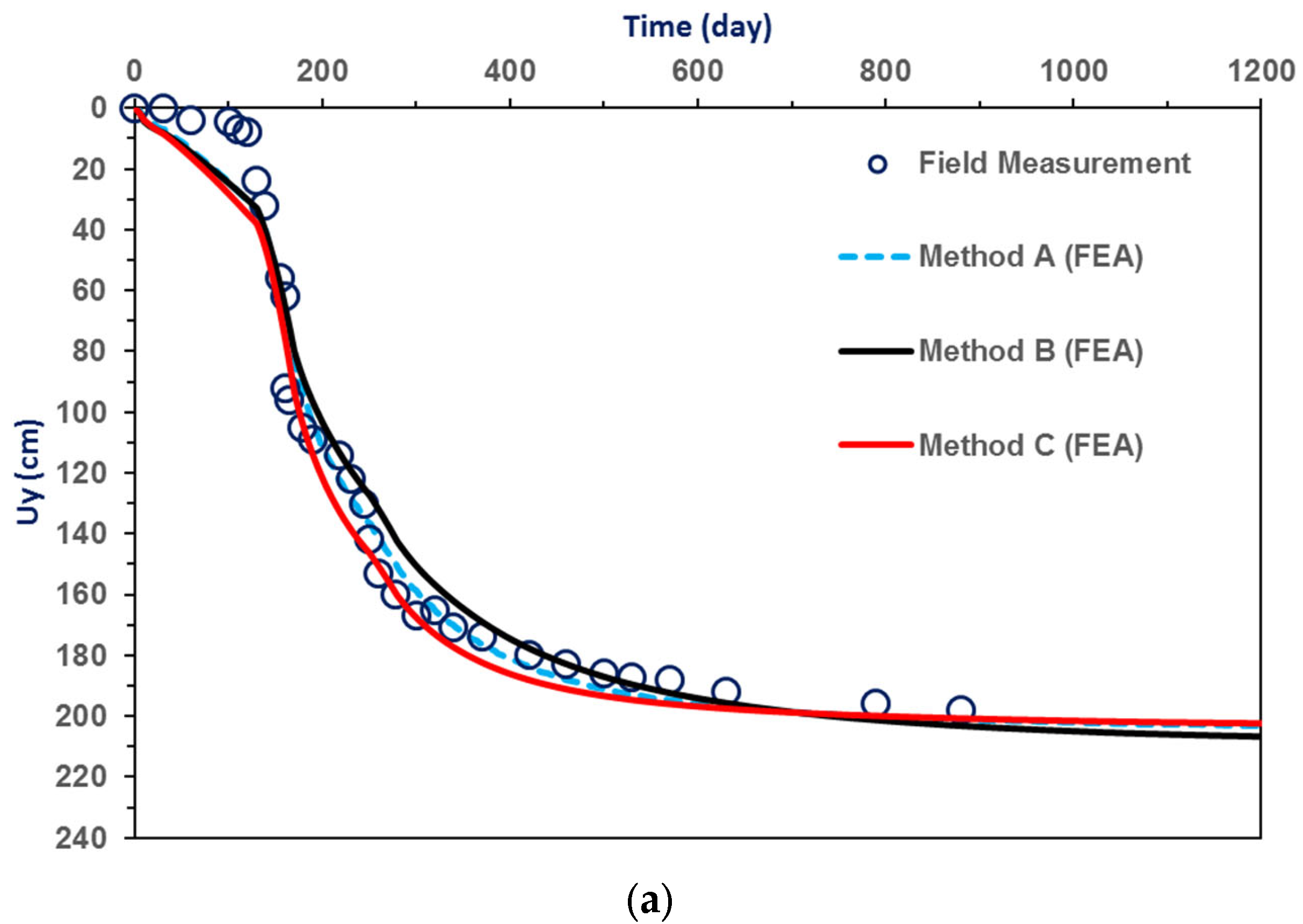
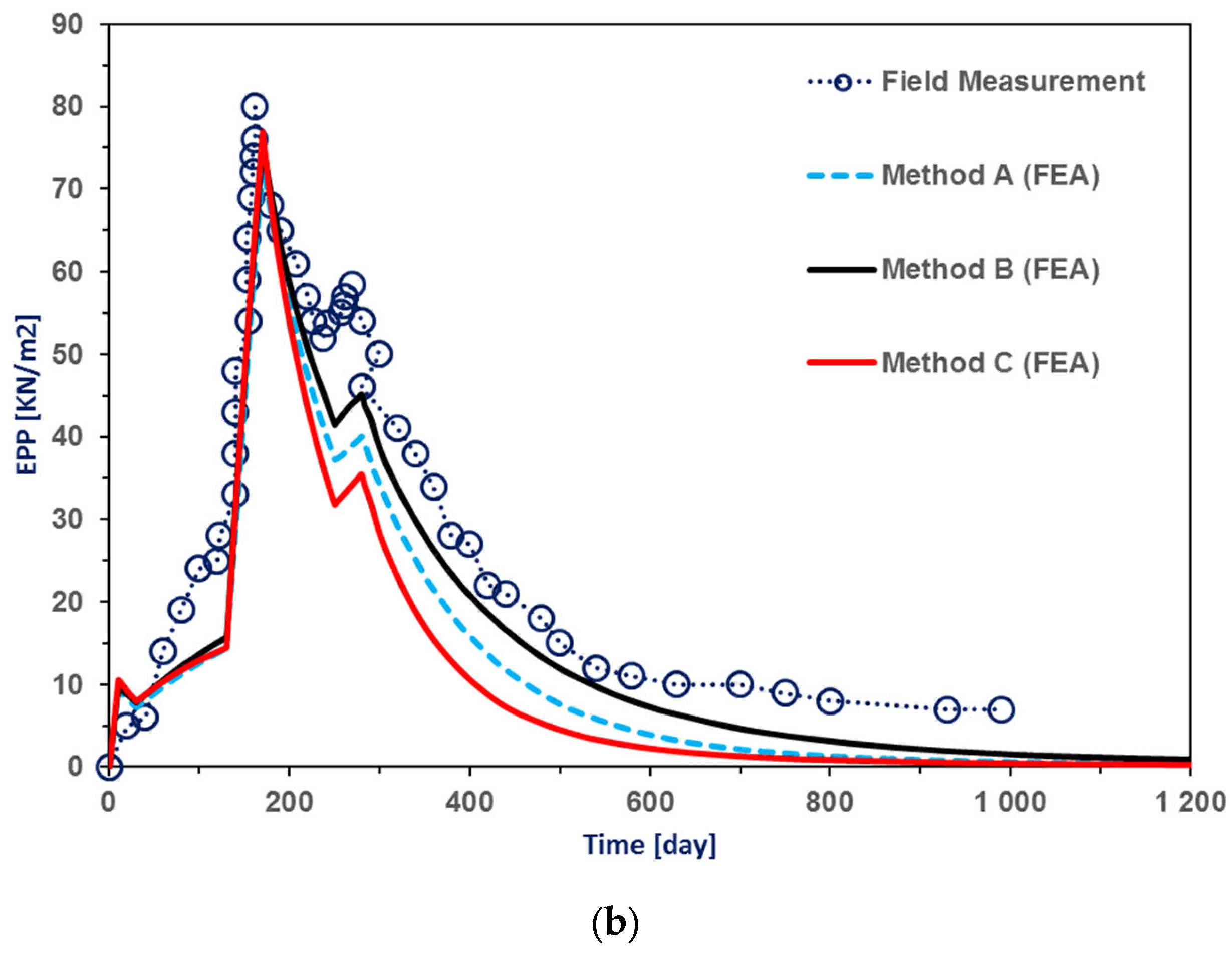
| Properties | Value |
|---|---|
| Liquid limit (%) | 102.24 |
| Plastic limit (%) | 39.55 |
| Water content (%) | 112.69 |
| Plasticity index | 62.69 |
| Total unit weight (kN/) | 14.70 |
| Specific gravity | 2.66 |
| Drainage | Polypropylene |
|---|---|
| Channels | 44 |
| Filter | Polypropylene |
| Weight (g/m) | 78 |
| Width, W (mm) | 100 |
| Thickness, td (mm) | 3.5 |
| H (m) | (kN/m3) | K* | λ* | ν | |
|---|---|---|---|---|---|
| 0.70 | 14.70 | 0.0167 | 0.173 | 0.3 | 2.29 |
| Parameters | Symbol | Unit | Value |
|---|---|---|---|
| Drain diameter | m | 0.0268 | |
| Diameter of smear zone | m | 0.087 | |
| Discharge capacity | /year | 100 | |
| Ratio of to | – | 3 |
| Layer | H (m) | E (kPa) | (kN/m3) | K* | λ* | ν | OCR | ||
|---|---|---|---|---|---|---|---|---|---|
| TC | 1 | – | 19.3 | 0.004 | 0.044 | 0.3 | 0.81 | 0.365 | 5 |
| SC1 | 4 | – | 18.5 | 0.008 | 0.077 | 0.35 | 1.07 | 0.482 | 1 |
| MC | 10 | – | 17.3 | 0.012 | 0.119 | 0.35 | 1.36 | 0.612 | 1 |
| SMC | 4 | – | 17.9 | 0.009 | 0.086 | 0.35 | 1.1 | 0.495 | 1 |
| SC2 | 5 | – | 19.3 | 0.006 | 0.055 | 0.3 | 0.81 | 0.365 | 1 |
| CS | 5 | 25,000 | 19.5 | – | – | 0.25 | – | – | – |
| Fill | 5.88 | 30,000 | 20 | – | – | 0.2 | – | – | – |
| Item | Symbol | Unit | Value |
|---|---|---|---|
| Drain diameter | m | 0.053 | |
| Unit cell diameter | m | 1.58 | |
| Space of PVD | S | m | 1.5 |
| Smear zone diameter | m | 0.355 | |
| Ratio of over in field | – | 13.8 | |
| Length of PVD | L | m | 19 |
| Discharge capacity | /year | 100 |
| Equivalent Permeability | |||||
|---|---|---|---|---|---|
| Laboratory Test | Method A | Method B | Method C | ||
| (m/day) | (m/day) | (m/day) | (m/day) | (m/day) | (m/day) |
| Equivalent Permeability | ||||||
|---|---|---|---|---|---|---|
| In Situ | Method A | Method B | Method C | |||
| Layers | (m/day) | (m/day) | (m/day) | (m/day) | (m/day) | (m/day) |
| TC | ||||||
| SC1 | ||||||
| MC | ||||||
| SMC | ||||||
| SC2 | – | – | – | – | ||
| SC | – | – | – | – | ||
| Fill | – | – | – | – | ||
Disclaimer/Publisher’s Note: The statements, opinions and data contained in all publications are solely those of the individual author(s) and contributor(s) and not of MDPI and/or the editor(s). MDPI and/or the editor(s) disclaim responsibility for any injury to people or property resulting from any ideas, methods, instructions or products referred to in the content. |
© 2024 by the authors. Licensee MDPI, Basel, Switzerland. This article is an open access article distributed under the terms and conditions of the Creative Commons Attribution (CC BY) license (https://creativecommons.org/licenses/by/4.0/).
Share and Cite
Théodore, A.; Demir, A.; Yildiz, A. 2D Numerical Analysis of Prefabricated Vertical Drains Using Different Matching Methods. Appl. Sci. 2024, 14, 4970. https://doi.org/10.3390/app14124970
Théodore A, Demir A, Yildiz A. 2D Numerical Analysis of Prefabricated Vertical Drains Using Different Matching Methods. Applied Sciences. 2024; 14(12):4970. https://doi.org/10.3390/app14124970
Chicago/Turabian StyleThéodore, Abrasse, Ahmet Demir, and Abdulazim Yildiz. 2024. "2D Numerical Analysis of Prefabricated Vertical Drains Using Different Matching Methods" Applied Sciences 14, no. 12: 4970. https://doi.org/10.3390/app14124970






